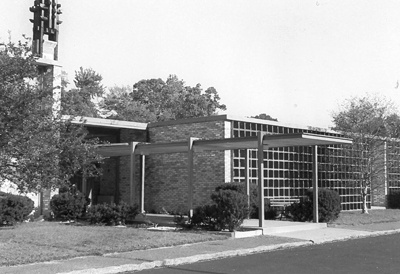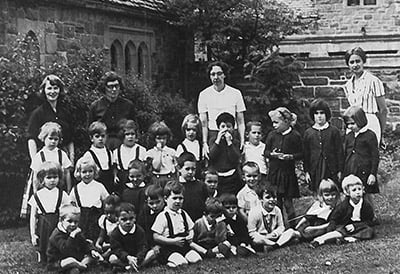Many parents come to Whitby because they’ve heard about our Montessori program. They’ve heard that it inspires students to become passionate, lifelong learners—and that it’s completely different from a traditional education where a teacher stands at the front of the classroom.
A little over 100 years ago, however, an Italian doctor named Maria Montessori changed education forever when she proposed a revolutionary child-centered education model. Today we’d like to share the story of the founding of the Montessori education, and reveal how Whitby contributed to the rise of Montessori within the United States.
What is the Montessori Education?

Unlike the traditional teacher-centered education, the Montessori education is focused on inspiring children to drive their own learning. Teachers guide the students and provide help, while encouraging students to choose their tasks and decide how to best approach each challenge.
Children who attend Montessori schools learn to value cooperation, stay within the framework of rules and think about how their actions affect others. Students retain their creativity and push themselves to excel due to their love of learning and their own natural curiosity. Above and beyond standard school subjects, Montessori students are taught how to fit a larger worldview into their thinking and encouraged to be curious and creative students.
Here’s a look at the history of the Montessori education:
1907: The Founding Years
At the beginning of the 20th century, Dr. Maria Montessori, Italy's first female doctor, opened the Casa dei Bambini (Children's House) to provide education to low-income children in Rome. Instead of using traditional teaching methods, Maria Montessori began testing her own child-centered educational theories in the classroom.
The Casa dei Bambini was unique because it focused on educating each child based on his or her development stage. Dr. Montessori encouraged children to take ownership of what they wanted to learn and worked with each child to create a personalized education that played to that child’s strengths. Children were encouraged to cooperate and work together to accomplish their goals.
In 1909, Dr. Montessori described her educational process in detail in Il Metodo della Pedagogia Scientifica applicato all’educazione infantile nelle Case dei Bambini. Titled The Montessori Education in English, her book captured the attention of educators all over the world and in the next two decades, Montessori schools sprang up on all six continents.
In 1929, she founded the Association Montessori Internationale to provide teacher education and guidance to the many Montessori schools opening around the world. Today, Maria Montessori is known as one of the foremost pioneers of education in the 20th century.
The Early 1900s: Montessori First Comes to America
In the United States, The Montessori Education made a big impression. By 1912, Dr. Montessori was a sought-after speaker on this side of the Atlantic and there were over 100 Montessori schools in the U.S by the end of 1913.
As the Montessori Method gained popularity, however, it also inspired detractors. In 1914, educational reformer William Heard Kilpatrick, published The Montessori System Examined, which criticized Maria Montessori for her focus on individualism and using the senses to help children learn. A student of educational reformer John Dewey, he subscribed to Dewey’s progressive education theory and called the Montessori method outdated.
As a popular professor at Columbia University’s influential Teachers College, Kilpatrick’s campaign against the Montessori method caused it to fall out of favor with educators. At the same time, John Dewey was advancing his educational philosophies as a distinguished professor at Columbia University and as president of the National Kindergarten Association. As a result, by 1920, there were virtually no Montessori schools left in the U.S.
1958: Nancy McCormick Rambusch and Whitby Bring Montessori Back to America
 Forty
years after the Montessori method was forgotten in America, it was
revived by parents who were passionate about finding a better way to
educate their children.
Forty
years after the Montessori method was forgotten in America, it was
revived by parents who were passionate about finding a better way to
educate their children.
Passionate about educating children, New York educator Dr. Nancy McCormick Rambusch underwent Montessori teacher training in London. In 1952, she traveled to the Tenth International Montessori Congress in Paris to learn how she could incorporate its teachings in her own classroom. Which she was at the conference, she met Mario Montessori and was inspired by him to find a way to revive his mother’s education method in the United States.
After returning home, Dr. Rambusch started teaching the Montessori method to small groups of children in New York City. Then she was approached by a small group of parents from nearby Connecticut, who were interested in founding a private school based on the Montessori education.
On September 29, 1958, the first Whitby School was opened in a carriage house just outside Greenwich, Connecticut. The school’s name was inspired a story from Whitby Abbey in Yorkshire, England where an Abbess invited a stable boy to join their education program after she recognized his musical talent.
As other parents learned about Whitby’s unique education, the school rapidly attracted more students and the first official Whitby campus was established in 1960. Whitby’s success also inspired renewed interest across the United States in the Montessori education.
Letters and people poured into Whitby from across the United States, demanding insistently that writers and visitors be given help in starting Montessori schools and teacher training programs.
- Montessori Comes to America by Phyllis Povell. pg 74
As interest grew in the Montessori education, Dr. Rambusch founded the American Montessori Society (AMS), where she modeled the ideal classroom after the Whitby program. The Whitby School also became the first certified Montessori teacher training program in the U.S.
Over the next few decades, the number of Montessori schools in the U.S. soared as educators and parents learned how this unique teaching method could build children's confidence, creativity and love of learning.
The Montessori Education Today
The Montessori education has a long record of success preparing children to take on the challenges of the future. Many parents choose this type of education because of its long and proven history and the way it works closely with each child's level of development. Successful Montessori graduates include Peter Drucker, Julia Child, Jeff Bezos, Sean ‘P.Diddy’ Combs, Katherine Graham, Helen Hunt, and Google founders Larry Page and Sergey Brin.
Today, the Montessori classroom is still centered around children and their educational interests and uses the latest findings about child development to ensure that each child's education is appropriate for their level of development. The American Montessori Society is the largest organization in the world dedicated to the Montessori method, with more than 1,300 affiliated schools and almost 100 teacher-education programs.
At Whitby School, we continue to teach according to the principles of Maria Montessori and Whitby/American Montessori Society founder Dr. Nancy McCormick Rambusch. Our Montessori preschool educates children from 18 months through kindergarten and we continue the Montessori education for children in Grades 1 and 2 in our private elementary school (accredited with non-traditional Montessori age groupings.)
If you’re considering a Montessori preschool for your child and would like to learn more about the Whitby School, we invite you to schedule a tour of our campus.
